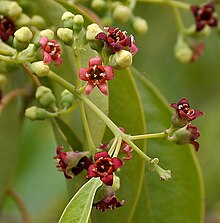Santen (chemical compound)
| Structural formula | ||||||||||
|---|---|---|---|---|---|---|---|---|---|---|

|
||||||||||
| General | ||||||||||
| Surname | Santen | |||||||||
| other names |
|
|||||||||
| Molecular formula | C 9 H 14 | |||||||||
| Brief description |
Liquid with an unpleasant smell |
|||||||||
| External identifiers / databases | ||||||||||
|
||||||||||
| properties | ||||||||||
| Molar mass | 122.21 g mol −1 | |||||||||
| Physical state |
liquid |
|||||||||
| density |
0.87 g cm −3 (at 17 ° C) |
|||||||||
| boiling point |
139-142 ° C |
|||||||||
| solubility |
soluble in acetone and benzene |
|||||||||
| Refractive index |
1.4688 (at 17 ° C) |
|||||||||
| safety instructions | ||||||||||
|
||||||||||
| As far as possible and customary, SI units are used. Unless otherwise noted, the data given apply to standard conditions . Refractive index: Na-D line , 20 ° C | ||||||||||
Santen (stress on the second syllable: Sant e n ) is a natural product that is one of the bridged cyclic hydrocarbons .
Occurrence
It is a component of essential oils, more precisely sandalwood oil and spruce needle oil . Santen was isolated there for the first time in 1900 by Friedrich Müller.
Extraction and presentation
Santen can be obtained by reducing camphenilone , then reacting with phosphorus pentachloride and splitting off hydrogen chloride . It can also be obtained from fenchols or norborneol .
Individual evidence
- ↑ M. Bergmann, K. Boresch, R. Brieger, FW Dafert, O. Dischendorfer, W. Dürr, F. Ehrlich, F. Evers, K. Freudenberg, M. Gierth, M. Hadders, L. Kalb, P. Karrer, G. Klein, L. Kofler, F. Kögl, D. Krüger, R. Lillig, F. Mayer, H. Pringsheim, L. Rosenthaler, H. Rupe, M. Schaerer, W. Schneider, W. Sutthoff, W. Thies, HK Thomas, A. Treibs, C. Wehmer, L. Zechmeister, F. Zetzsche: Special Analysis of Organic Substances II . Springer-Verlag, 2013, ISBN 978-3-7091-2230-3 , pp. 571 ( limited preview in Google Book search).
- ↑ a b c David R. Lide: CRC Handbook of Chemistry and Physics, 85th Edition . CRC Press, 2004, ISBN 0-8493-0485-7 , pp. 194 ( limited preview in Google Book search).
- ^ A b Brockhaus ABC Chemie , VEB FA Brockhaus Verlag Leipzig 1965, p. 1229.
- ↑ This substance has either not yet been classified with regard to its hazardousness or a reliable and citable source has not yet been found.
- ↑ Hugo Von Soden: About the components of the East Indian sandalwood oil. In: Archives of Pharmacy. 238, 1900, pp. 353-366, doi: 10.1002 / ardp.19002380506 .
- ↑ Friedrich Müller: On the knowledge of the East Indian sandalwood oil. In: Archives of Pharmacy. 238, 1900, pp. 366-383, doi: 10.1002 / ardp.19002380507 .
- ↑ JL Simonsen: The Terpenes Volume II The Dicyclic Terpenes, Sesquiterpenes and their Derivatives . 1932, p. 206 ( limited preview in Google Book search).
- ↑ Emil Abderhalden : tannins, lichen substances, saponins, bitter substances, terpenes, essential oils, resins, rubber . Springer-Verlag, 2013, ISBN 978-3-642-51316-9 , pp. 266 ( limited preview in Google Book search).
